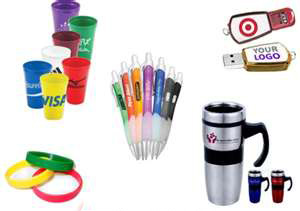 Combined with the right strategy, promotional items can be a worthwhile marketing investment. However, simply having your logo slapped on a mug, hat, pen or other giveaway item doesn’t guarantee it’s money well spent.
Combined with the right strategy, promotional items can be a worthwhile marketing investment. However, simply having your logo slapped on a mug, hat, pen or other giveaway item doesn’t guarantee it’s money well spent.
To get the full potential and the greatest value from your promotional products, here are some considerations to keep in mind:
1 – Your Brand Message
Start with your message, not an item you like. What kinds of items are consistent with the brand you intend to convey? What sort of impression should prospects and clients have about your company? Is it trustworthy, fun, hip, or conservative? Do you have a tagline that would be supported by a specific item? Would you like your item to spark conversation, be played with, or be used daily?
2 – Consistency
When designing your promotional products, be sure to use the same logo, fonts, colors, and overall look as you do on the rest of your marketing materials. It’s critical to maintain consistency of your brand by selecting a product and imagery that matches and compliments your company’s purpose, not just as a matter of professionalism, but because people respond better to a single, consistent message.
Availability is another important consideration. Will you be able to order more of this particular item later if it turns out to be extremely popular and you want to purchase more? Don’t choose discontinued items or those only available for a limited time, even if there is a cost savings. Along those same lines, if you think something is going to be very popular, you might want to order more than you think you’ll need right away.
3 – Quality
Attractive, appealing, high-quality promotional products can last for years, reflecting an enduring, high-quality image of your company. When selecting your promotional items, don’t focus solely on price, but make sure you work with an established company that has a good reputation and reliable service. Junky trinkets not only don’t help your marketing efforts – they can damage your image as items break and are thrown away.
4 – Recipients
Who will receive your promotional items? Thinking about your target audience will help you select the right item for your intended recipient. It doesn’t matter what you personally would like, or even what is the most popular selling item. All that matters is what the recipient would enjoy and find most useful.
5 – Distribution
Will your promotional items be given away in-store, at an event, or by sales reps in the field? Sometimes, these practical considerations can affect the kind of items you choose, as a matter of weight and portability. It doesn’t make much sense to hand out a mug at a street fair, for example.
Similarly, the context for distribution can give you a powerful opportunity to be useful to your recipients. Notebooks, pens or USB drives at a conference. Sun visors or hats at an outdoor event. Fun toys for kids at a family event.
6 – Call to Action
Often, promotional items are treated as a way to create brand awareness. However, using a promotional item as a tool to encourage potential customers to take action, whether it is visiting your website or bringing the item into your store is a powerful way to leverage the investment.
For this sort of promotion you might distribute the products at various types of events to encourage a follow-up contact to receive a free product or service, a significant coupon, or a drawing for attractive prizes. This can be combined with a telemarketing campaign or other types of promotion like email or SMS. By using this method, you can track the results and therefore calculate your return on investment.
Also, don’t overlook the power of using high-quality promotional gifts to say thank you to customers, employees, sponsors, or anyone who helps you with your business. You’re giving the person a nice present, but with your logo printed on the item, it will also serve as an ongoing reminder of your company.
About the author: Richard Larson is Brand Manager at GoPromotional.com, a top seller of corportate gifts and promotional items in the UK.